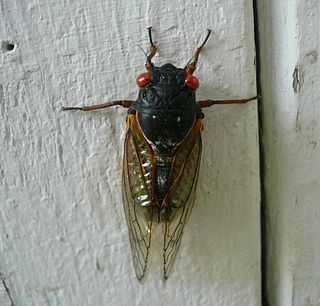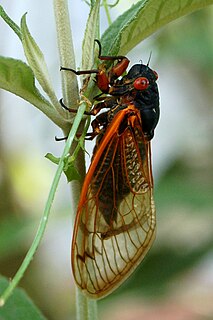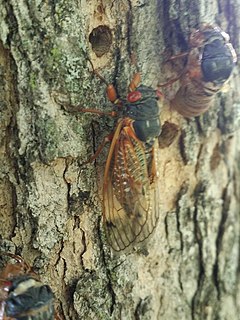Map of brood locations

Brood IX (Brood 9), is one of 15 broods of periodical cicadas that appear regularly throughout the United States in 13 or 17-year intervals. Seventeen-year Brood IX is concentrated in Virginia, West Virginia, and North Carolina. [1]
Every 17 years in select locations in the eastern US, cicadas tunnel en masse to the surface of the ground, mate, lay eggs, and then die off in several weeks. The combination of long dormancy, the simultaneous emergence of vast numbers, and the short period before the nymphs' burrowing underground to safety allows the brood to survive even massive predation. [2] Brood IX remained underground in the Southern United States after emerging in 2003 and next emerged during the spring of 2020. [3] The emergence of Brood IX will not overlap with Brood X in spring 2021. [1]


The cicadas are a superfamily, the Cicadoidea, of insects in the order Hemiptera. They are in the suborder Auchenorrhyncha, along with smaller jumping bugs such as leafhoppers and froghoppers. The superfamily is divided into two families, the Tettigarctidae, with two species in Australia, and the Cicadidae, with more than 3,000 species described from around the world; many species remain undescribed.

Brood X, the Great Eastern Brood, is one of 15 broods of periodical cicadas that appear regularly throughout the eastern United States. The brood's first major emergence after 2021 is predicted to occur during 2038.

Magicicada is the genus of the 13-year and 17-year periodical cicadas of eastern North America, consisting of seven species. Although they are sometimes called "locusts", this is a misnomer, as cicadas belong to the taxonomic order Hemiptera, suborder Auchenorrhyncha, while locusts are grasshoppers belonging to the order Orthoptera. Magicicada belongs to the cicada tribe Lamotialnini, a group of genera with representatives in Australia, Africa, and Asia, as well as the Americas.

Charles Lester Marlatt (1863–1954) was an American entomologist. Born in 1863 at Atchison, Kansas, he was educated at Kansas State Agricultural College, where he was assistant professor for two years. He is the person who introduced the ladybug insect Chilocorus similis into the United States to control the San Jose scale insect, which was first discovered in San Jose, California in 1880 by John Henry Comstock and named by him. Marlatt worked for the Bureau of Entomology, United States Department of Agriculture. In 1912 he was appointed chairman of the Federal Horticultural Board. He was president of the Entomological Society of Washington in 1897–98 and of the American Association of Economic Entomologists in 1899.

Brood XIII is one of 15 separate broods of periodical cicadas that appear regularly throughout the midwestern United States. Every 17 years, Brood XIII tunnels en masse to the surface of the ground, mates, lays eggs, and then dies off in several weeks.

Brood XIX is the largest brood of 13-year periodical cicadas, last seen in 2011 across a wide stretch of the southeastern United States. Periodical cicadas are often referred to as "17-year locusts" because most of the known distinct broods have a 17-year life cycle. Brood XIX is one of only three surviving broods with a 13-year cycle. It is also notable because it includes four different 13-year species, one of which was discovered in Brood XIX in 1998 by scientists listening to cicada songs.

Magicicada cassini known as the 17-year cicada, Cassin's periodical cicada or the dwarf periodical cicada, is a species of periodical cicada. It is endemic to North America. It has a 17-year life cycle but is otherwise indistinguishable from the 13-year periodical cicada Magicicada tredecassini. The two species are usually discussed together as "cassini periodical cicadas" or "cassini-type periodical cicadas." Unlike other periodical cicadas, cassini-type males may synchronize their courting behavior so that tens of thousands of males sing and fly in unison. The species was first described by Margaretta Morris. However, the specific name cassini was in honour of John Cassin, an American ornithologist.

Magicicada septendecim, sometimes called the Pharaoh cicada or the 17-year locust, is native to Canada and the United States and is the largest and most northern species of periodical cicada with a 17-year lifecycle.

Massospora cicadina is a fungal pathogen that infects only 13 and 17 year periodical cicadas. Infection results in a "plug" of spores that replaces the end of the cicada's abdomen while it is still alive, leading to infertility, disease transmission, and eventual death of the cicada.
Brood XIV is one of 15 separate broods of periodical cicadas that appear regularly throughout the midwestern and northeastern United States. Every 17 years, the cicadas of Brood XIV tunnel en masse to the surface of the ground, mate, lay eggs, and then die off in several weeks.
Magicicada neotredecim is the most recently discovered species of periodical cicada. Like all Magicicada species, M. neotredecim has reddish eyes and wing veins and a black dorsal thorax. It has a 13-year life cycle but seems to be most closely related to the 17-year species Magicicada septendecim. Both species are distinguished by broad orange stripes on the abdomen and a unique high-pitched song said to resemble someone calling "weeeee-whoa" or "Pharaoh." They differ only in life cycle length.

Decim periodical cicadas is a term used to group three closely related species of periodical cicadas: Magicicada septendecim, Magicicada tredecim, and Magicicada neotredecim. M. septendecim, first described by Carl Linnaeus, has a 17-year life cycle; the name septendecim is Latin for 17. M. tredecim, first described in 1868, has a similar call and appearance but a 13-year life cycle; tredecim is Latin for 13. M. neotredecim, first described in 2000 by Marshall and Cooley in an article in the journal Evolution, is a 13-year species but otherwise much more similar to M. septendecim than to M. tredecim as shown by studies of DNA and abdominal color variation by Chris Simon and colleagues in a companion article in the same journal issue.

Brood II is one of 15 separate broods of Magicicada that appear regularly throughout the northeastern United States. Every 17 years, Brood II tunnels en masse to the surface of the ground, mates, lays eggs, and then dies off over the span of several weeks.
Brood XXII is a brood of 13-year periodical cicadas, last seen in 2014 in a geographic region centered on Baton Rouge, Louisiana, as well as other locations in southeast Louisiana and southwest Mississippi. Periodical cicadas are often referred to as "17-year locusts" because most of the known distinct broods have a 17-year life cycle. Brood XXII is one of only three surviving broods with a 13-year cycle. The next emergence of The Baton Rouge Brood is expected in 2027.

Brood V is one of twelve extant broods of periodical cicadas that emerge as adults once every 17 years in North America. They are expected to appear in the eastern half of Ohio, the southwestern corner of Pennsylvania, the upper two-thirds of West Virginia less the Eastern Panhandle, far western Maryland, and some places in Virginia abutting West Virginia. Also included in Brood V is a population that emerges in Suffolk County, Long Island, New York. They last emerged in 2016, and their next appearance will be in 2033.

Brood XXIII is a brood of 13-year periodical cicadas that last emerged in 2015 around the Mississippi River in the states of Louisiana, Mississippi, Arkansas, Tennessee, Missouri, Kentucky, and Illinois. The brood was also seen in Southwestern Indiana and Western Kentucky around the Ohio River, and as far north as Weldon Springs State Park in DeWitt County, Illinois. Brood XXIII is one of three extant periodical cicada broods with a 13-year life cycle, and thus is expected to be seen again in 2028.
Brood XXI was a brood of 13-year periodical cicadas that inhabited the Florida Panhandle and the area around the Alabama–Mississippi border. It was last seen in 1870 and is presumed extinct.
Brood I is a brood of 17-year periodical cicadas that inhabits Western Virginia and West Virginia. It last emerged in 2012 and is expected to be seen again in 2029.
Brood III is a brood of 17-year periodical cicadas that is endemic only to the US state of Iowa. It last emerged in 2014 and is expected to be seen again in 2031.
Brood VII is a brood of 17-year periodical cicadas that inhabits the central New York state counties of Onondaga, Cayuga, Seneca, Ontario, and Yates. It last emerged in 2018 and is expected to be seen again in 2035.